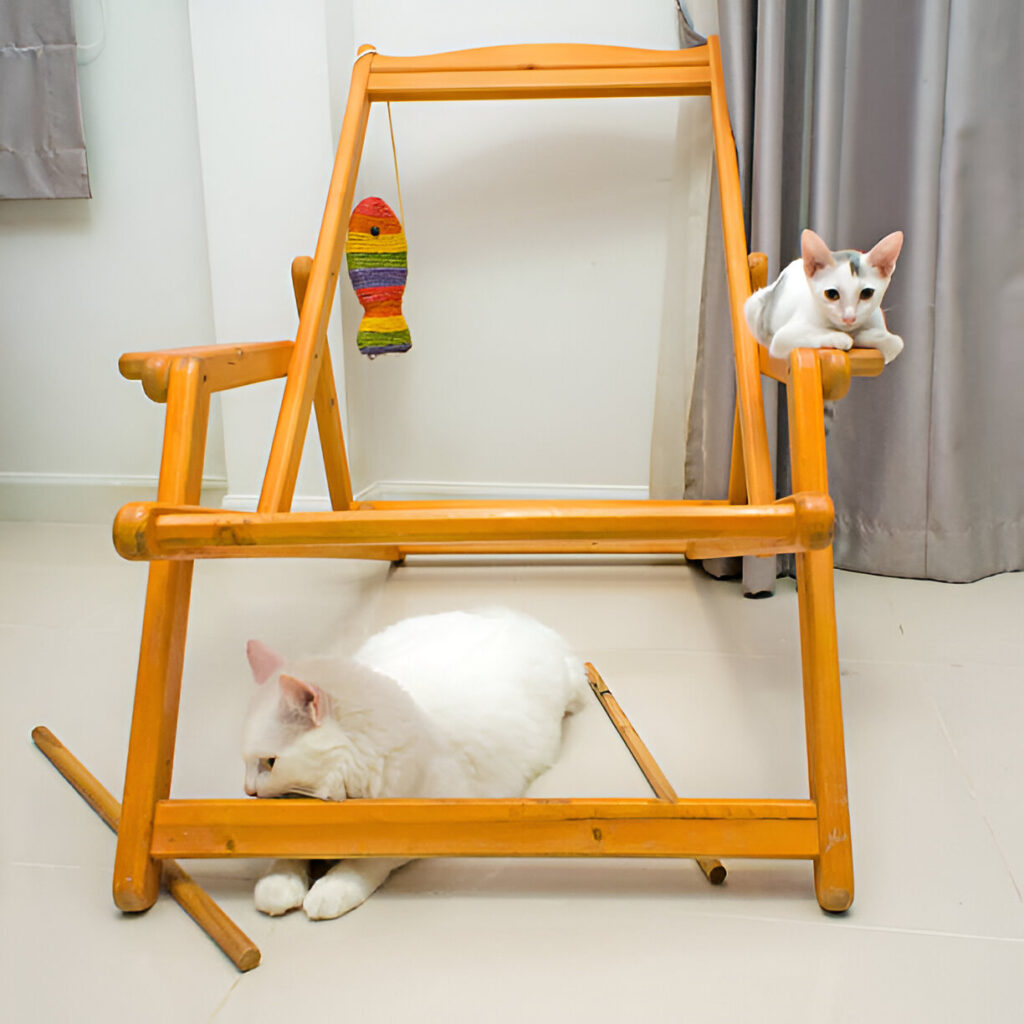Planning Your Cat Climbing Frame
Getting ready to build a cat climbing frame is exciting! A well-planned design will keep your kitty happy and active. Let’s look at the key steps to create the perfect cat playground for your home.
Choosing the Right Location
Pick a spot your cat already likes. Look for areas where they often sit or play. Windows are great choices – cats love to watch the outside world. Corner spaces work well too. They give your cat a sense of safety.
Make sure the area has enough room. Your cat needs space to jump and climb freely. Check that the walls can support the frame’s weight. Avoid places with lots of foot traffic to keep your cat feeling secure.
Think about how the frame will fit with your decor. You want it to look good in your home. Consider painting it to match your walls or furniture.
Designing for Your Space
Measure your chosen area carefully. This helps you plan the right size frame. Draw a rough sketch of your ideas. Include different levels and platforms for your cat to explore.
Think about your cat’s age and abilities. Older cats may need gentler slopes and wider platforms. Young, active cats might enjoy more vertical challenges.
Add fun features like scratching posts and dangling toys. These keep your cat engaged. Plan for cozy spots where your cat can nap or hide.
If you live in an apartment, focus on vertical space. Tall cat trees or wall-mounted shelves work great in smaller homes.
Materials and Tools Needed
Choose sturdy materials that can hold your cat’s weight. Solid wood or MDF are good options for platforms. Sisal rope is perfect for scratch-friendly areas.
You’ll need:
- Wood or MDF boards
- Carpet or faux fur for comfort
- Screws and brackets
- A drill and saw
- Measuring tape and level
- Stud finder (for wall-mounted designs)
Don’t forget safety items:
- Sandpaper to smooth rough edges
- Non-toxic paint or stain
- Soft materials for padding
Pick tools you’re comfortable using. If you’re new to DIY, start simple. You can always add more complex features later.
Building the Base and Structure
A solid foundation and sturdy frame are key to creating a safe, long-lasting cat climbing frame. Let’s look at how to build a stable base and assemble the main structure for your DIY cat tree.
Creating a Stable Foundation
Start with a wide, heavy base to prevent tipping. Cut a 24-inch square piece of 3/4-inch plywood for the bottom. Sand the edges smooth to avoid splinters. Attach four 2×4 boards underneath in a square pattern for added weight and stability.
Use a level to make sure the base sits flat. If needed, add small rubber feet to each corner. This will protect your floor and allow for minor adjustments on uneven surfaces.
For extra stability, you can bolt the base to the floor. But this is optional for most home setups.
Assembling the Frame
Now it’s time to build upwards. Choose sturdy materials like 4×4 posts or thick PVC pipes for the main supports. Cut them to your desired height – typically 4-6 feet works well for most spaces.
Secure the posts to the base using heavy-duty brackets and screws. Make sure they’re perfectly vertical using a level. For added strength, use diagonal braces between posts.
Create platforms at different heights using plywood circles or squares. Attach them to the posts with strong L-brackets. Add screw hooks to hang toys or hammocks.
Wrap the posts in sisal rope for scratching. Start at the bottom, apply wood glue, and wind tightly upwards. Secure the ends with staples.
Adding the Climbing Elements
Let’s make your cat climbing frame fun and exciting! We’ll add shelves, a climbing wall, and a cozy condo for your feline friend to enjoy.
Attaching Cat Shelves
Cat shelves are great spots for your kitty to perch and observe. Pick sturdy shelves that can hold your cat’s weight. Use a stud finder to locate wall studs for secure mounting. Mark the spots and drill pilot holes. Attach brackets to the wall with screws, then place the shelves on top.
Space the shelves at different heights. This lets your cat jump between them easily. Cover the shelves with carpet or sisal rope for better grip. Add some soft cushions or beds on wider shelves for comfy napping spots.
Building the Climbing Wall
A climbing wall gives your cat a vertical playground. Start with a large piece of plywood as your base. Cover it with carpet or sisal rope for traction. Attach various climbing elements like:
- Small wooden blocks
- Rope ladders
- Scratch posts
- Dangling toys
Mix up the textures and shapes to keep things interesting. Make sure everything is securely fastened to the plywood. You can lean the climbing wall against a regular wall or attach it for extra stability.
Incorporating a Cat Condo
A cat condo adds a cozy retreat to your climbing frame. You can buy a pre-made one or build your own. If building, use sturdy cardboard boxes or wooden crates. Cover them with soft fabric or carpet.
Create multiple levels inside the condo. Add small openings between levels for your cat to explore. Place the condo at the base of your climbing frame. This gives your kitty a safe space to rest after playtime.
Don’t forget to add some fun extras like hanging toys or a scratching post near the condo entrance. Your cat will love having their own little house within the climbing frame!
Decorating and Finishing Touches
After building the frame, it’s time to make it cozy and fun for your cat. Let’s look at how to choose materials and add some flair to your DIY cat climbing frame.
Selecting Durable Materials
Pick sturdy fabrics that can handle cat claws. Sisal rope is great for scratching posts. Wrap it tightly around parts of the frame. Your cat will love digging their claws into it.
For comfy spots to rest, try carpet or faux fur. Stick to neutral colors that match your home. Cut pieces to fit platforms and ledges. Glue them down securely so they don’t come loose.
MDF boards work well for shelves and hiding spots. They’re cheap and easy to cut. Cover them with fabric for a softer touch.
Applying Finishes and Paint
Paint bare wood to protect it and make it look nice. Choose non-toxic, water-based paints. Avoid strong smells that might bother your cat.
Add fun patterns or paw prints with stencils. Let your creativity shine! Just make sure the paint is fully dry before letting your cat play.
For a natural look, try wood stains. They bring out the grain while keeping the wood safe for cats. Seal everything with a clear, non-toxic finish to make it last longer.
Safety and Maintenance
Building a cat climbing frame is fun, but keeping it safe and clean is key. Let’s look at how to make sure your kitty’s playground stays secure and tidy.
Ensuring Stability and Security
Check your cat climbing frame often for loose parts. Tighten screws and bolts as needed. Make sure platforms and shelves are firmly attached to the wall or frame. Look for signs of wear on sisal rope and replace it if it’s fraying.
Test the frame’s stability by gently shaking it. If it wobbles, adjust the base or add support. Cover sharp edges with padding to prevent injuries. Choose non-toxic materials and paints for your cat’s safety.
Keep the frame away from windows to avoid falls. Place soft cushions at the bottom as a safety precaution. Watch your cat use the frame at first to spot any potential hazards.
Cleaning and Upkeep
Clean your cat’s climbing frame regularly to keep it fresh. Vacuum or brush off fur and dust weekly. Wipe down surfaces with a damp cloth and mild soap. Let everything dry completely before letting your cat play again.
Check for any signs of damage like scratches or bite marks. Sand down rough spots to prevent splinters. Replace worn-out parts promptly to keep the frame safe and fun.
Wash removable fabric items like hammocks or cushions monthly. Refresh sisal rope by brushing it with a wire brush. Spray a pet-safe deodorizer occasionally to keep smells at bay.
Trim your cat’s nails regularly to reduce wear on the frame. Rotate toys or scratching posts on the frame to keep your kitty interested. This helps spread out wear and tear too.

